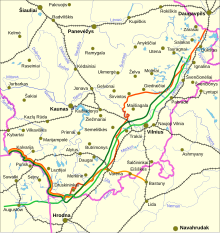Foch line
The Foch Line was an interim line of demarcation between Poland and Lithuania , proposed by the Entente shortly after the First World War by Marshal of France Ferdinand Foch and accepted by the Paris Ambassadors Conference in 1919. With slight changes it became the base of the border between Lithuania and Poland in the interwar period, although the capital (already of the Grand Duchy of Lithuania ) Vilna was annexed to Poland. After the Second World War, when the borders of the Peace of Riga were withdrawn from the Polish-Soviet War and the new border in eastern Poland was drawn according to the Curzon Line at the Tehran Conference , only the westernmost part of the Foch Line still formed the state border.
bibliography
Alfred Erich Senn: Lithuania in European Politics: The Years of the First Republic, 1918–1940. Edited by Edvardas Tuskenis. Palgrave Macmillan 1998. ISBN 978-0-312-17232-9 = Lithuania in European Politics: The Years of the First Republic, 1918–1940. in Google Book Search. 72. Palgrave Macmillan 1999. ISBN 978-0-312-22458-5 . Retrieved October 7, 2019.
See also
Individual evidence
- ↑ The extent to which this demarcation was controversial for a long time can be seen from descriptions of Polish farmers in the southern part of East Prussia in 1987. They reported that during Wojciech Jaruzelski's state visit to Lithuania shortly before, half of Poland had been watching television to get impressions of the cityscape after decades.
